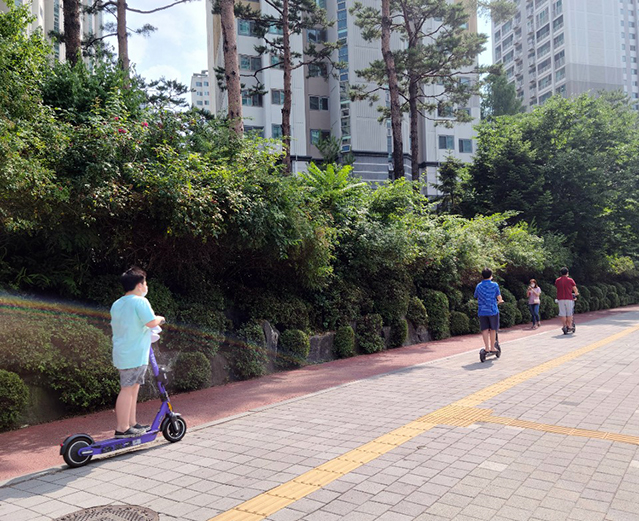Summer is back and so are the whizzes of electric scooters. Since the beginning of 2019, these communal automobiles have been all the rage among young adults in South Korea. With Kick-Going kicking off the trend, different electric scooter companies, such as Go-go-ssing, Ssing-ssing, DART, and Lime, have been vying for customers, expanding their businesses. These eco-friendly vehicles are allegedly a smart and affordable means to roam about, but is this a valid claim? It turns out there are legitimate voices on either side of the debate.
People claim that an e-scooter is the perfect solution to traveling distances that are vague: too far to walk but too close to drive. They are faster than buses or subways because they eliminate the inconvenience of having to stop at every unnecessary station, only to walk some more. In other words, e-scooters save time. They are especially helpful during rush hours since they can weave in and out of crowded streets, getting users to their destinations more quickly than a car would. “I always take the electric scooter to get home during rush hour. It only takes 10 minutes, whereas riding a bus would take me over 30 minutes,” says Seung-Ryul Lee, an avid user of Kick-Going. He says he owns a car but does not drive it to work because e-scooters are faster. “Back and forth, it saves me more than 40 minutes in total. That’s a lot.”

Speed does not seem to be the only perk. Lee claims that electric scooters reduce the hassle of securing a parking spot. “It’s impossible to find a parking space in Gangnam. That’s why I take the e-scooters. I can just park them anywhere.” Furthermore, e-scooters are affordable. For a short distance, they may be a little more expensive than a bus fare but are definitely much cheaper than the basic fare of taxis. For those that believe “time is gold,” electric scooters seem to be the most economic mode of transportation.
Besides convenience and cost, e-scooters provide users with enjoyment. Due to the fast speed that cannot be experienced from other slower vehicles, people favor scooters. The average speed of a scooter is 10km/h more than the bicycle, which is 23km/h. Moreover, scooters are not physically demanding,” Lee stated. “I love how the cool breeze that rushes as I ride the scooters.”
In May 2020, the National Assembly of the Republic of Korea passed an amendment to the traffic laws regarding electric scooters. Although initially scooters were permitted only on the road, they are now also allowed on bicycle lanes. Of course, there are regulations that riders must follow, such as wearing a helmet, owning a driver’s license, riding individually (one person per scooter), and not using a phone. Those who violate these rules can be fined: riding without a helmet is approximately $20, riding on the sidewalk is $40 in addition to 10 penalty points, and riding without a license is either a $300 fine or 1 to 30 days of jail time.
As clear as these regulations are, people do not seem to take them seriously. It is easy to see flagrant violations: riding without helmets, appropriating others’ IDs, or riding in tandem. To begin with, it is rare to see people wearing helmets during the rides. Seung-Ryul Lee revealed why he does not wear helmets during his rides. “I know I should wear a helmet, but I don’t because it messes up my hair and makes me sweaty. Besides, I don’t want to be carrying a helmet around everywhere. It’s so inconvenient,” he said.

What is worse, people without driver’s licenses ride e-scooters, using their acquaintances’IDs. Such reckless action has even led Hee-Eun Lim, a 32-year-old female driver, to experience a close call. “I almost hit a kid riding a scooter because he came out of nowhere. I don’t think he was aware of cars coming. Kids without licenses shouldn’t be riding the scooters, but so many of them do. I’m really concerned,” Lim said with dismay. That was not all. Lim claimed that the kid had his earphones nestled in his ears, which could have blocked out warning sounds from passing cars.


Even those with licenses are not abiding by the “ride for one” rule. In other words, people are illegally riding electric scooters in tandem. They may object and claim that they are spending a harmless time with their friends, lovers, or even their children. However, there are also those who oppose such riding habits. When asked on this subject, Lim expressed her concern. “What if one of them makes a mistake and the other falls off? Wouldn’t that cause a bigger accident? People should ride with caution.”

There is also the problem of people parking the electric scooters in surreptitious, or downright ridiculous, locations. Although the scooter mobile apps require users to upload a photo of the scooter and its location upon its parking, people disregard this process and end up docking them in inappropriate or inaccessible spaces--in the middle of a street, a narrow alleyway, or between buildings, making it nearly impossible for e-scooter companies to locate and collect these gadgets.
Of course, electric scooters were introduced for our convenience, but are we ready? Seeing that there is still a lot of apprehension regarding the e-scooters despite new traffic laws, it seems worth asking ourselves if we are truly being responsible for our given comfort. It would all depend on our due diligence on public safety.

Soo-A Hong
Sophomore (Grade 10)
Cebu International School

